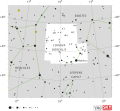Beta Pyxidis, Latinized from β Pyxidis, is a double star located in the southern constellation Pyxis. It has an apparent visual magnitude of 3.954, making...
9 KB (743 words) - 19:55, 1 June 2025
Alpha Pyxidis, Latinised from α Pyxidis, is a giant star in the constellation Pyxis. It is the brightest star in Pyxis, and is easily visible to the naked...
8 KB (589 words) - 19:54, 1 June 2025
RZ Pyxidis is eclipsing binary system in the constellation Pyxis, made up of two young stars less than two millions years old. Both are hot blue-white...
3 KB (194 words) - 22:54, 8 December 2024
413 ± 2 G0 7.63 HD 110506 414 B9Vn HD 187421 414 ± 2 A1/3 V 6.37±0.01 Beta Pyxidis 416 G5III HATS-72 (Zembra) 416 K4 Gamma Chamaeleontis 418 ± 6 K5 III...
15 KB (130 words) - 07:02, 15 June 2025
Committee of Photographic Magnitudes in 1913. In 1913, Leavitt discovered T Pyxidis, a recurrent nova in the constellation Pyxis, and one of the most frequent...
29 KB (3,017 words) - 20:51, 21 June 2025
TOI-178 204.9 ± 0.6 K7V 11.95 Has 6 exoplanets. Wolf 354 206.4 K3D Gamma Pyxidis 207 K2.5III Kepler-37 208.7 ± 0.1 G8V 9.710 Has 3 confirmed and 1 unconfirmed...
14 KB (130 words) - 16:38, 14 June 2025
Borealis is one of a handful of stars called recurrent novae, which include T Pyxidis and U Scorpii. An outburst of T Coronae Borealis was first recorded in...
55 KB (6,300 words) - 06:17, 23 June 2025
DS Andromedae (category Beta Lyrae variables)
Michel (August 1968). "Photoelectric Observations of DS Andromedae and RZ Pyxidis". Publications of the Astronomical Society of the Pacific. 80 (475): 417...
12 KB (744 words) - 16:29, 30 October 2024
planets WISE 1653+4444 39.5 T8 Gliese 3304 39.53 ± 1.43 M4.5V HR 3384 (11 G. Pyxidis) 39.7 ± 0.3 Pyxis G9V 6.38 V538 Aurigae 39.9 ± 0.4 Auriga K1V 6.25 System...
37 KB (1,691 words) - 06:44, 12 June 2025
may be more distant, at 1165 light-years away. The candidate planet AT Pyxidis b may also be more distant, at ~1207 light-years away. Among rogue planets...
131 KB (8,805 words) - 15:50, 25 June 2025





